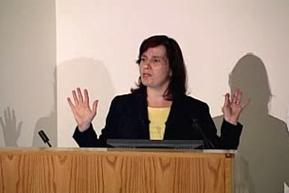Eastern Brains
Probing the partnership between Buddhism and the brain sciences

Click here to watch Anne Harrington on BUniverse. Download available on iTunesU.
Harvard Professor Anne Harringtondiscusses the relationship between neuroscience, cognitive science, andBuddhism in the first lecture of the Religious and PsychologicalWell-Being Project series sponsored by the Center for the Study ofReligion and Psychology at the Danielsen Institute. She recalls a 2005 Society for Neuroscience conference, where the Dalai Lamaspoke on The Neuroscience of Meditation. He talked to the 13,000attendees about his curiosity about the world, his affection forscience, its benefits for happiness and health, and his belief thatscience and Buddhism have a lot of constructive things to say to eachother. Harrington then asks a key question, “What in the world doesTibetan Buddhism have to do with brain science?”
The rest of her talk attempts to answer the question. Harringtontraces the history of U.S. interest in Tibetan Buddhism, talking aboutthe fascination with the eastern brain and transcendental meditationduring the1960s and 1970s counterculture. She refers to the research ofthe University of Wisconsin’s Richard Davidson on the brain functionsof Buddhist monks during long periods of meditation. She touches onstudies done by scientists and neuroscientists over the years, fromRobert Keith Wallace’s research on meditation as a “fourth major stateof consciousness” to the research on stress and its relation to health,in particular cardiac health, of Harvard Medical School’s Herbert Benson.
Many scientists have attempted to study the physiology of advancedmeditation, she says, but it wasn’t until the late 1990s that with thehelp and influence of Buddhist monk and scientist Matthieu Ricard andauthor and scholar Robert Thurman there was progress in the field.Because of America’s love affair with Tibet, because Buddhism isfriendly to science, and because of the encouragement of the DalaiLama, a partnership between Tibetan Buddhism and brain science is notso anomalous as it may first appear, according to Harrington.
About the Speaker:
Anne Harringtonis a professor and chair of the history of science at HarvardUniversity and a Harvard College Professor. She specializes in thehistory of psychiatry, neuroscience, and the other mind sciences. Sheis also Visiting Professor for Medical History at the London School ofEconomics, where she coedits the new journal Biosocieties.
Harrington received her Ph.D. in the history of science from OxfordUniversity and has held postdoctoral fellowships at the WellcomeInstitute for the History of Medicine in London and at the Universityof Freiburg in Germany. Currently she serves on the Board of the Mind and Life Institute, an organization dedicated to cross-cultural dialogue between Buddhism and the sciences.
She is the author of Medicine, Mind and the Double Brain, Reenchanted Science, and The Cure Within: A History of Mind-Body Medicine and has published many articles and several edited collections.
Comments & Discussion
Boston University moderates comments to facilitate an informed, substantive, civil conversation. Abusive, profane, self-promotional, misleading, incoherent or off-topic comments will be rejected. Moderators are staffed during regular business hours (EST) and can only accept comments written in English. Statistics or facts must include a citation or a link to the citation.